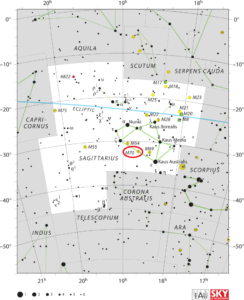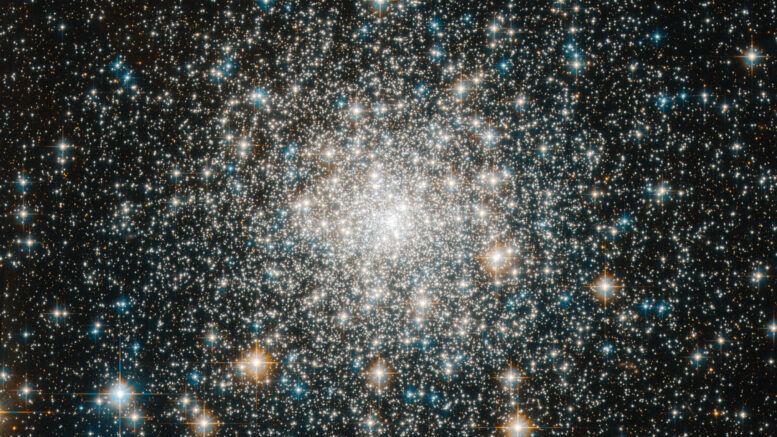Messier 70 (M70) is a globular cluster located inside the Teapot asterism in the southern constellation Sagittarius. M70 was discovered by Charles Messier in 1780. It is located 30,000 light-years away in the constellation Sagittarius. With an apparent magnitude of 9.1, the cluster can be observed through a small telescope best in the month of August.
| Description | |
| Visible From Pacific Northwest | May To August |
| Best Time To Observe | June And July |
| Minimum Size Of Viewing Device | Small Telescope |
| Object Type | Globular Cluster |
| Designations | Messier 70, M70, NGC 6681, GCl 101, C 1840-323, MWSC 2981 |
| Right Ascension | 18h 43m 12.76s |
| Declination | -32°17’31.6” |
| Constellation | Sagittarius |
| Number Of Stars | 75,000 |
| Apparent magnitude | +9.06 |
| Apparent dimensions | 8′ |
| Object Radius | 34 light years |
| Distance From Earth | 29,400 light years |
History
Messier 70 was discovered by Charles Messier on August 31, 1780, the same night he found M69.
William Herschel was the first to resolve the stars in M70 and found it similar to Messier 3. After observing the cluster on July 13, 1784, he described it as “extremely rich, considerably bright, pretty large, irregularly round,“ noting a “very faint red perceivable.“
John Herschel catalogued M70 as h 3756, describing it as a “globular cluster; bright; round; gradually much brighter toward the middle; diameter in RA = 7.0s [1.75′]; resolved into stars of 14 to 17 m.“ He later added the cluster to the General Catalogue as GC 4428.
Locating M70 In The Sky
Messier 70 is pretty easy to find using the Teapot asterism. It is located almost exactly halfway between the two stars at the base of the Teapot: Kaus Australis, Epsilon Sagittarii, and Ascella, Zeta Sagittarii. The best time of year to observe M70 is during the months of June, and July, but it can be a difficult target for northern observers because it never rises high above the southern horizon.

Viewing M70
In binoculars, M70 appears like an out-of-focus star and is best observed with a telescope. Individual stars in the cluster can only be resolved with large amateur telescopes, but even small ones will reveal a distinctly non-stellar object, with a bright core inside a fuzzy ball of light. 10-inch telescopes will resolve the stars in the outer regions of the cluster.
Photographing M70
Messier 70 isn’t necessarily the most popular target, but there are some great websites with some tips and help for those looking to image the object. The best way to find tips will be looking through astrobin and forums like cloudynights. The larger the telescope, the more detail will be revealed, but also will the capture time will increase.
Sources And Further Reading
Descriptions of all of Messier Objects can be found here.
https://www.messier.seds.org/Mdes/dm070.html
https://www.nasa.gov/feature/goddard/2017/messier-70
https://freestarcharts.com/messier-70

Be the first to comment on "Messier 70"